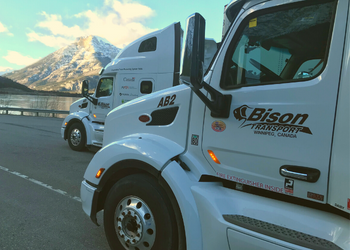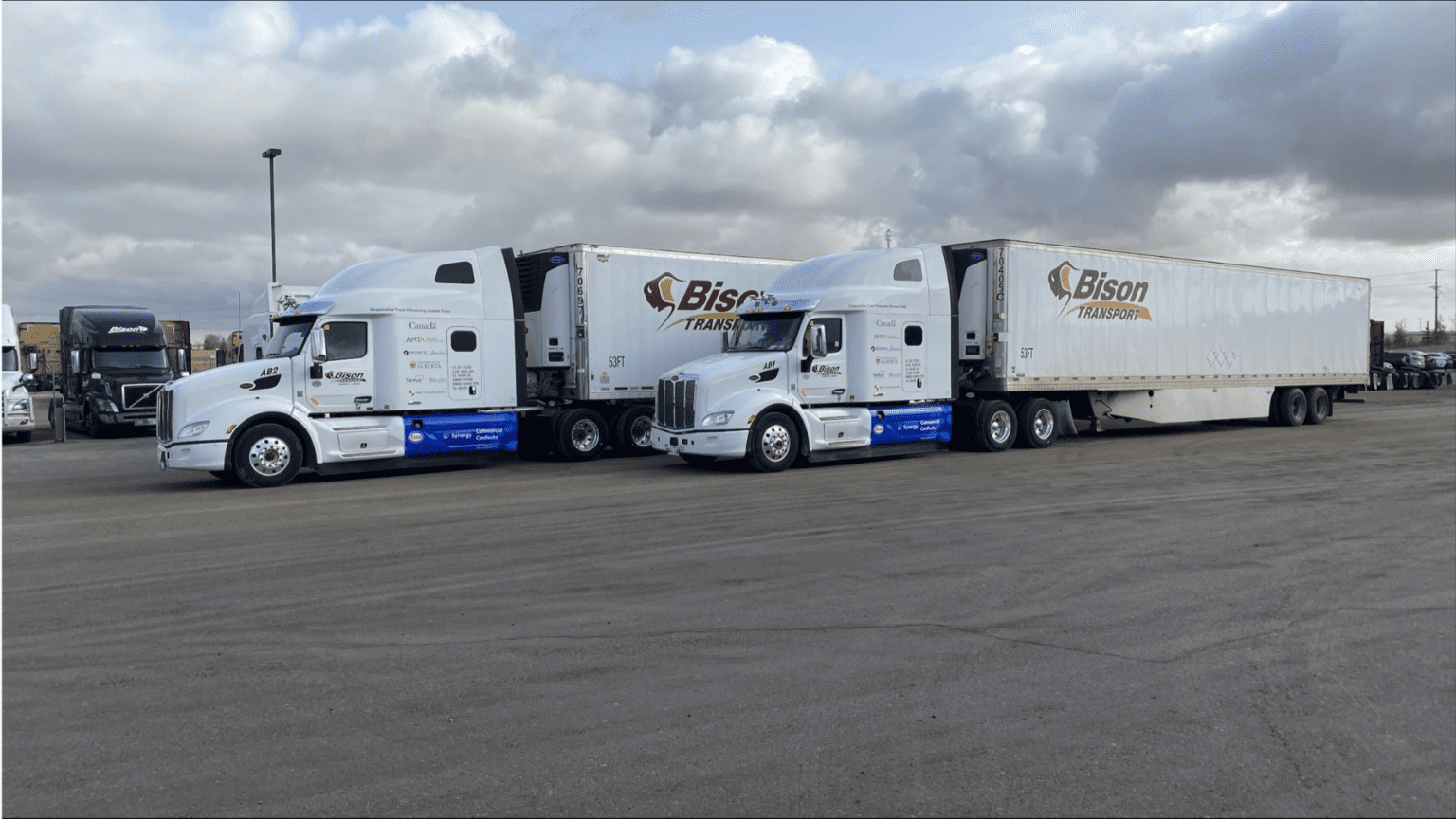COOPERATIVE TRUCK PLATOONING SYSTEM (CTPS)
The Alberta Motor Transport Association and our project partners celebrated the successful completion of Canada’s first Cooperative Truck Platooning System (CTPS) trials in March 2022.
Truck platooning requires critical vehicle data to be continuously transmitted by a central computer system on a lead truck to a follower truck (or trucks). The electronic connection supports steering and braking/acceleration as the trucks respond to each other and interact with road traffic. Platooning allows multiple vehicles to follow closely, reduce air drag, and increase vehicle fuel efficiency.
Transportation is moving towards a future with connected and automated vehicle technology. As entrepreneurs and original equipment manufacturers (OEMs) develop and integrate these automated driving systems (ADS) in our vehicles there is a need to understand the benefits, capabilities, and limitations of these technologies. AMTA was excited to engage in real-world trials to reduce the current knowledge gap regarding the safety and reliability of these systems to help inform critical decision-makers on how to safely introduce ADS vehicles to Alberta’s roads.
The goals of the trial were to:
Validate vehicle safety
Evaluate fuel consumption
Review tailpipe emissions and air pollutants
Examine traffic flow interactions
Assess the driver experience
Create awareness of automated and connected vehicle technologies
The Cooperative Truck Platooning System (CTPS) trials successfully demonstrated two electronically hitched heavy-duty vehicles as they supported Bison fleet operations. The connected automated vehicles (CAVs) were equipped with Level 2 driving automation with lane-centering, and adaptive cruise control features. The vehicles platooned in a “road train” formation and the trucks traveled at three, four, or five-second intervals. The trials evaluated fuel efficiency, greenhouse gas emissions, traffic interactions, and the driver’s experience. The CTPS trial is the first Canadian trial to demonstrate Level 2 driving automation on public roads, supporting fleet business operations, and funded in part by Transport Canada.
Prior to on-road trials in Alberta, extensive track testing took place at Transport Canada’s Motor Vehicle Test Centre in Blainville, Quebec. Track testing validated technology readiness through system monitoring and oversight that was completed during 225 track tests. Testing of the response of the automated vehicle system was done in a variety of situations including single truck breaking, platooning braking, vehicle cut-ins in front of the lead vehicle, vehicle cut-ins between the platooning trucks, sudden reveal traffic, automatic emergency braking, vehicle connectivity, as well as daylight and nighttime operations were tested. Following track testing, the two retrofit Peterbilt 579 Class 8 trucks were equipped with radar, cameras, GPS, a vehicle-to-vehicle communication system, and other data gathering sensors. On-road trials were conducted from October 2021 to February 2022 in Alberta on Highway 2 from Calgary to Edmonton return.
A variety of stationary and remote-controlled vehicles were used at the track to simulate traffic interactions. The first interactions were completed with stationary soft targets to ensure the Level 2 autonomous technology would brake without driver intervention when encountering an object on the road. Testing then progressed to simulate moving traffic interactions using a remote-controlled soft target. A foam vehicle was mounted on a skateboard-type frame and remotely controlled to cut in front of, or between the autonomous trucks. Trials then graduated to using a computer-controlled car that was able to travel at highway speeds. The computer-controlled car was programmed to cut in front of and/or in between the vehicles at exact specified distances. This vehicle was manned and equipped with a ‘dead man switch,’ that allowed the driver to easily abort the test if the driver felt unsafe. During track tests, the drivers sitting in the lead and follower trucks were asked to allow the truck to steer and brake waiting for the last possible moment to intervene allowing the onboard vehicle computer to be tested. Once the truck technology was validated, demonstrations progressed to road trials.
Real-world trials reduce the current knowledge gap regarding the safety and reliability of these systems and help inform critical decision-makers on how to safely introduce ADS (automated driving system) vehicles to Alberta’s roads. This test project was completed on Alberta’s Queen Elizabeth Highway II – the major transportation corridor between Edmonton and Calgary.
“Daisy” and “Lily” the two 2020 Peterbilt 579s, were equipped with Pronto AI’s Co-pilot System (you can view Daisy and Lily in action here). The retrofit automated driving system provided both steering (lane-centering) and acceleration and braking (adaptive cruise control). This driver-assisted technology provides insights into fuel and operational efficiencies. Data collected through these trials will help evaluate the effects that driver-assisted technologies have on both the lead and following truck drivers. Workload, stress, and passive fatigue are primary factors that were evaluated through these dynamic on-road trails.
Over 41 trips were conducted from January 12-20, 2022, in which 23,115 km were travelled, nine Bison Transport drivers and 10 dedicated researchers monitored the collection of 13 data sources. The findings of these trials have been compiled into a comprehensive report, which can be viewed here.
For more information on the press releases that have been released on these trials, please see the links below:
To look at the on-track private validation testing that took place in Blainville, Quebec, you can view a video on the CTPS on-track private track validation testing before coming to Alberta here.
To learn more about the test parameters and variables for the Alberta trials, you can view the CTPS Final On-Road Trial Report here.
To fully understand the impact of automation and platooning on drivers, as well as gather information on the full driver experience during these trials, you can view the Driver Experience Assessment Report here.
We would like to thank our partners who helped make this trial a success:
















